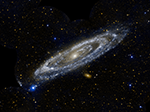Hubble's Constant and Distance to M31

You now know that you need two pieces of information in order to use Hubble's Law to solve for M31's velocity: the distance to M31 and Hubble's constant.
Looking up "distance to M31" on the web, it is easy to find that the Andromeda galaxy (the other name for M31) is 2.5 million light years (or 2.5×106 light years). Even though that sounds like it's very far away, Andromeda is actually one of our nearest galaxy neighbors.
The value of Hubble's constant, H0, has been a topic of ongoing research and observation ever since Hubble discovered that there was a relationship between recession velocity and distance. The measured value of H0 changes as our observations improve. The number you find for H0 in your textbook is 68 km/sec/Mpc, which was reported in 2013 as a result of studies done with data from the Planck mission. You expect that your professor would want you to use this number, even if there has been an update in the research.
Note that "Mpc" stands for mega-parsecs, or 106 parsecs. And one parsec is about 3.3 light years. Be very careful keeping all of your units straight!


